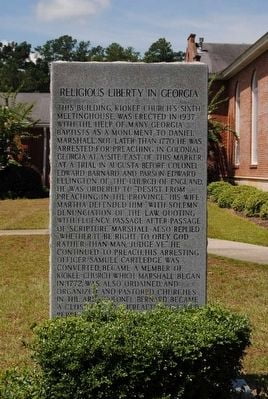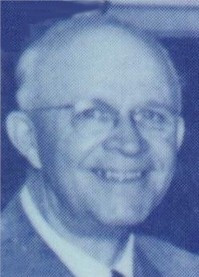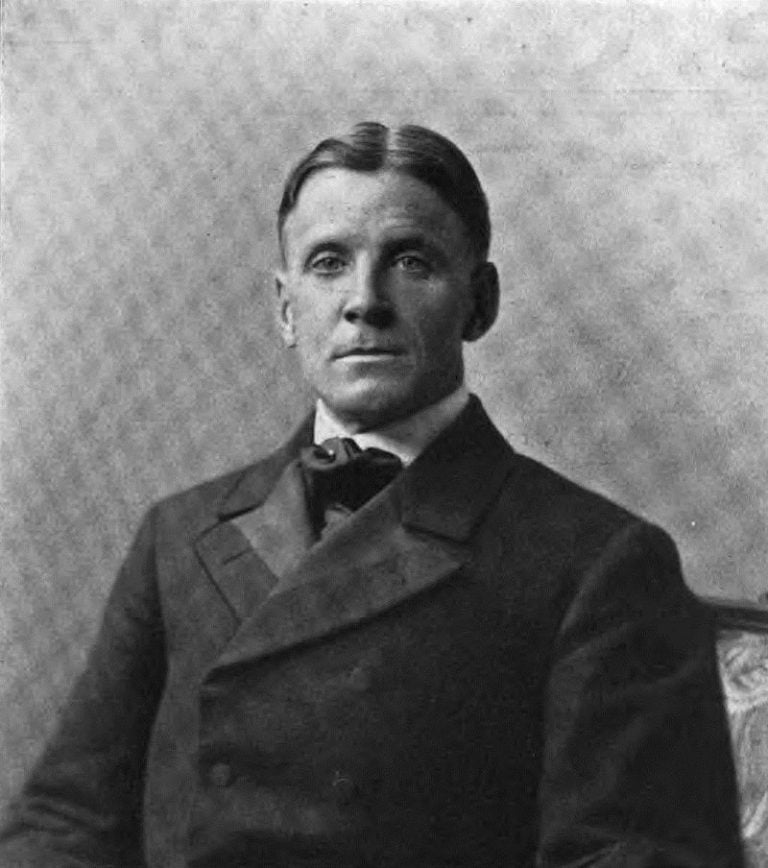Favorite
In the median of US 221, near the Appling courthouse, the people of Georgia, in 1903, erected a monument to Daniel Marshall and his “devotion and consecration…to the cause of Christ.” (See Chapter 15.). copyrighted and used by permission from David Beale, Baptist History in England and America: Personalities, Positions, and Practices Rev. Daniel Marshall Born 1706, Died 1784, Pioneer Read more...
Favorite
From the marker: This building, Kiokee Church’s sixth meeting house, was erected in 1937 with the help of many Georgia Baptists as a monument to Daniel Marshall. Not later than 1770, he was arrested for preaching in Colonial Georgia at a site east of this marker. At a trial in Augusta before Colonel Edward Barnard and Parson Edward Ellington of Read more...
Favorite
Pioneer missionary, John Mason Peck (1789-1858), saturated Missouri and Illinois with the gospel, evangelizing, organizing churches, and establishing the Baptist movement in the West. At Southern Illinois University Dental School, this memorial plaque highlights his life and legacy: On this site in 1831, John Mason Peck (1789-1858), pioneer Baptist preacher, author, and educator, established the school which became Shurtleff Read more...
Favorite
Hymn History: He Lives & Author: Alfred Henry Ackley “He once said, ‘The thought of His ever-living presence brought the music promptly and easily.’” (Bruce Creswell) The Origin of the Hymn “He Lives” (I Serve a Risen Savior) Few gospel hymns capture the joy and assurance of the resurrection as powerfully as “He Lives”, also known by its opening Read more...
Favorite
From Wikipedia: Upon receiving his degree in theology in 1882, Babcock became pastor of a church at Lockport, New York. He was described as having “an unusually brilliant intellect and stirring oratorical powers that commanded admiration, [that] won for him a foremost place among the favorites of his denomination”.[5] From 1887 to 1900, Babcock was senior minister of the prestigious Brown Read more...
Favorite
The Old Rugged Cross is one of the most beloved – and most claimed hymns! Our Christian Heritage has been to the Old Rugged Cross church on Pokagon, MI where it was first performed in its entirety and we’ve interviewed the couple that restored the church. We’ve also been to Sturgeon Bay, WI where the Friends Church is that it Read more...
Favorite
George Bennard was born in Youngstown, Ohio, but his parents would move to Iowa. When he was a teenager, he was invited to a Salvation Army meeting at 176 South 1st Avenue, Canton, Illinois, where he knelt at the “mourner’s bench” and accepted Jesus Christ as his Savior. The Canton Salvation Army still has that mourner’s bench on display. After Read more...
Favorite
From the website: The Old Rugged Cross Historical Museum is an outgrowth of a memorial cross erected and dedicated on September 14, 1954, north of Reed City, Michigan, near the home of Reverend and Mrs. George Bennard. Reverend Bennard was the author of well-loved hymn “The Old Rugged Cross” written in 1913. The museum presently contains mementos and relics not only Read more...
Favorite
John Blair Smith was the second president of Hampden-Sydney College, founded by his older brother. From Banner of Truth: This was certainly true at Hampden-Sydney and the President, John Blair Smith, also a Presbyterian pastor of two nearby, small congregations, Briery and Cub Creek, was deeply grieved. He and the members of his churches began to pray for revival Read more...
Favorite
From Banner of Truth: This was certainly true at Hampden-Sydney and the President, John Blair Smith, also a Presbyterian pastor of two nearby, small congregations, Briery and Cub Creek, was deeply grieved. He and the members of his churches began to pray for revival in their communities and at the college. In 1788 eighty young men were at the college and Read more...
Favorite
The log house occupied by the Presbyterian missionary to the Indians in 1744 was a short distance away on the side road. It was here the youthful zealot wrote part of his famed journal. Featured zImage Credit: Photo: David Brainerd Marker. www.hmdb.org/PhotoFullSize.asp?PhotoID=104167. Read more...
Favorite
David Brainerd (1718-1747) died at age 29, but inspired missionaries such as William Carey and Jim Eliot. He was a struggling farmer but during the Great Awakening on July 12, 1739, “the Lord… brought me to a hearty desire to exalt him, to set him on the throne, and to ‘seek first his Kingdom,’ i.e., principally and ultimately to aim Read more...
Favorite
Wikipedia Crosby and Rider moved to 226 Wells Street, Bridgeport, Connecticut in summer 1906 because of Rider’s cancer.[297] Carrie died of intestinal cancer in July 1907, and Phoebe Knapp died on July 10, 1908.[91] Weeks later, Ira Sankey died having just sung “Saved by Grace”, one of Crosby’s most popular compositions.[298] On May 2, 1911, Crosby spoke to 5,000 people at the opening meeting of the Read more...
Favorite
I left Wisconsin for a visit to Myanmar (ancient Burma), where throughout the entire country the legacy of Adoniram Judson (see Plymouth, MA) is visible. During my trip, I read the biography of Judson, To The Golden Shore. When it mentioned an individual with ties to Wisconsin, I had to learn more, and started digging thru the archives. Over a Read more...
Favorite
It was a five mile walk along the CB&Q railroad track, but the teenager, who also worked long hours at a coal mine, had heard about the Salvation Army meetings in Canton and decided he wanted to see what it was all about. Meetings at that time often lasted until 11 p.m., but after walking the five miles home after Read more...
Favorite
Rev. Robert Lowry was born in Philadelphia, Pennsylvania on March 12, 1826 and at age 22 entered the University of Lewisburg (now Bucknell University). After graduating at age 28 he served as pastor in West Chester, PA; New York City; Brooklyn; and then returned to Lewisburg, where he was a professor and received an honorary doctorate. Monument Text: The Read more...
Favorite
Reporter, Lawyer, and Pastor: The Author of “We Three Kings of Orient Are” Our journey fittingly begins considering the birth of Jesus. The words and music to this popular Christmas carol were composed by John Henry Hopkins Jr. in 1857, and they have been included in Methodist hymnals since 1935. Geographically, we begin at Christ Episcopal Church at Fourth Read more...
Favorite
Section S, Division 1, Lot 54 – 7 1/2 N 4 1/2 W From FindaGrave: Hymn Composer. The author of over 2,000 hymns which are still available in print, he is remembered his widely popular songs “What a Wonderful Savior!,” “Enough for Me,” “Is Thy Heart Right With God?,” “Are You Washed in the Blood?,” “No Other Friend Like Jesus,” Read more...
Favorite
James Milton Black (1856-1938) is widely known as the author of the words and music to the popular gospel song When the Roll is Called Up Yonder. He was, however, a very private person whose failure to leave much documentation about his work has frustrated musicologists for decades. No photograph of him suitable for large-size reproduction in gospel song histories, Read more...
Favorite
Reuben Archer Torrey, also known as R.A. Torrey, worked with Dwight L. Moody in Chicago, and became superintendent of what is now Moody Bible Institute, then-Chicago Evangelization Society. In 1894 he was pastor of Chicago Avenue (now Moody) Church. Heading to the West Coast, Torrey was dean of the Bible Institute Of Los Angeles (BIOLA), and in 1915 he was Read more...



















